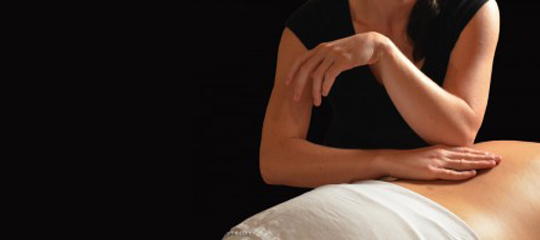Deep Tissue Massage
Deep Tissue Massage is a form of bodywork that aims to relieve chronic patterns of tension in the body through slow strokes and deep pressure on the contracted areas, either following or going across the grain of muscles, tendons, and fascia. Deep Tissue Massage is ideal for athletes and highly effective for releasing stress areas due to misalignment, repetitive motions, and past lingering injuries. Due to the nature of the deep tissue work, open communication during the session is crucial to avoid unnecessary discomfort. While this therapy is not meant to hurt, soreness is relatively common after the treatment, and plenty of water should be ingested to aid with the flushing and removal of toxins released during the session.
According to WebMD, “Deep tissue massage is best for giving attention to certain painful, stiff “trouble spots” in your body. The massage therapist uses slow, deliberate strokes that focus pressure on layers of muscles, tendons, or other tissues deep under your skin. Though less rhythmic than other types of massage, deep tissue massage can be quite therapeutic — relieving chronic patterns of tension and helping with muscle injuries, such as back sprain.”
“What is Deep Tissue Massage?
Deep tissue massage is a type of massage therapy that focuses on realigning deeper layers of muscles. It is used for chronic aches and pain and contracted areas such as a stiff neck and upper back, low back pain, leg muscle tightness, and sore shoulders.
Some of the strokes are the same as those used in classic massage therapy, but the movement is slower and the pressure is deeper and concentrated on areas of tension and pain in order to reach the sub-layer of muscles and the fascia (the connective tissue surrounding muscles).
How Does It Work? Techniques
With chronic muscle tension or injury, there may be adhesions (bands of painful, rigid tissue) in muscles, tendons, and ligaments. Adhesions can disrupt circulation and cause pain, limited movement, and inflammation. Deep tissue massage works by physically breaking down these adhesions to relieve pain and restore normal movement.
Does Deep Tissue Massage Hurt?
At certain points during the massage, most people find there is usually some discomfort and pain. It is important to tell the massage therapist when things hurt and if any soreness or pain you experience is outside your comfort range. There is usually some stiffness or pain after a deep tissue massage, but it should subside within a day or so. The massage therapist may recommend applying ice to the area after the massage.
Benefits of Deep Tissue Massage
Deep tissue massage usually focuses on a specific problem, such as chronic muscle pain, injury rehabilitation, and the following conditions:
- Chronic pain
- Lower back pain
- Limited mobility
- Recovery from injuries (e.g. whiplash, falls, sports injury)
- Repetitive strain injury, such as carpal tunnel syndrome
- Postural problems
- Muscle tension in the hamstrings, glutes, IT band, legs, quadriceps, rhomboids, upper back
- Osteoarthritis pain
- Sciatica
- Piriformis syndrome
- Tennis elbow
- Fibromyalgia
- Muscle tension or spasm
- After a workout or bodybuilding
According to Consumer Reports magazine, 34,000 people ranked deep tissue massage more effective in relieving osteoarthritis pain than physical therapy, exercise, prescription medications, chiropractic, acupuncture, diet, glucosamine and over-the-counter drugs. Deep tissue massage also received a top ranking for fibromyalgia pain. People often notice improved range of motion immediately after a deep tissue massage.
What Can I Expect During My Visit?
Massage therapists may use fingertips, knuckles, hands, elbows, and forearms during the deep tissue massage. The pressure is generally stronger than a regular massage. The strokes may be slower. You may be asked to breathe deeply as the massage therapist works on certain tense areas.
Precautions
Deep tissue massage may not be safe for people who with blood clots (e.g. thrombophlebitis, deep vein thrombosis), due to the risk that they may become dislodged. If you have blood clots or are at risk of forming blood clots, it’s essential that you consult your doctor first.
If you’ve had recent surgery, chemotherapy, radiation, or any other medical procedure, it’s wise to check with your doctor before starting massage therapy. Some people with osteoporosis should avoid the deeper pressure of this type of massage. Massage should not be done directly over bruises, inflamed or infected skin, skin rashes, unhealed or open wounds, tumors, abdominal hernia, fragile bones, or areas of recent fractures.
Pregnant women should check with their doctor first if they are considering getting a massage. Deep tissue massage (or any strong pressure) should be avoided during pregnancy, but your doctor may suggest a massage therapist trained in pregnancy massage.
Tips and After Care
- Don’t eat a heavy meal before the massage.
- If it’s your first time at the clinic or spa, arrive at least 10 minutes early to complete the necessary forms. Otherwise, arrive 5 minutes early so you can have a few minutes to rest and relax before starting the massage.
- A deep tissue massage may result in muscle soreness or tenderness, which may last a day or two. Your massage therapist may recommend icing any painful areas.
- Drinking water after the massage may help to flush out toxins that are released from muscles and properly rehydrate muscles, which can help to reduce muscle aches and stiffness after a massage.
- Avoid strenuous activity after a massage.
- Stretching can help to prevent muscle aches and pain after a deep tissue massage.
Disclaimer: The information contained on this site is intended for educational purposes only and is not a substitute for advice, diagnosis or treatment by a licensed physician. It is not meant to cover all possible precautions, drug interactions, circumstances or adverse effects. You should seek prompt medical care for any health issues and consult your doctor before using alternative medicine or making a change to your regimen.”
-Cathy Wong, ND, Alternative Medicine Expert


